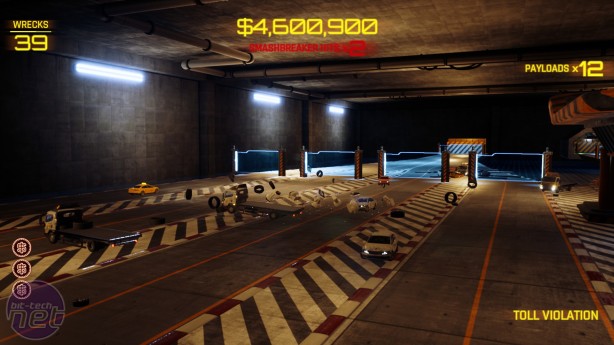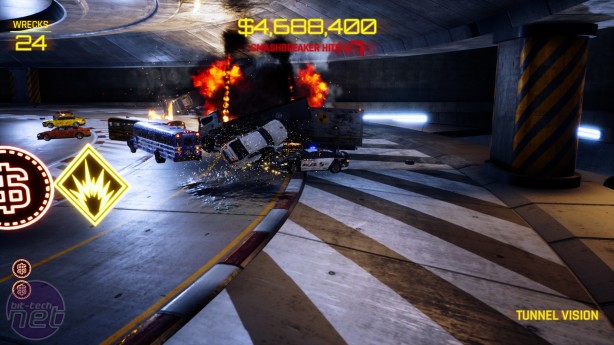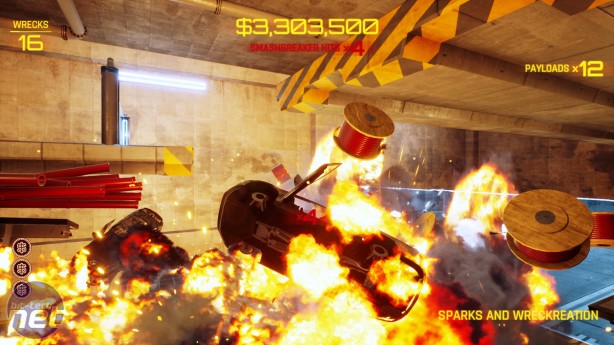
As Danger Zone progresses, it evolves from being a simple celebration of twisted metal and flying sparks into a game of tactical destruction. You must time your Smashbreakers not only to deal the maximum damage possible but to propel you to the next Smashbreaker pickup so you can chain crashes together. Each stage begins with a flyover of the road you’re about to fill with wreckage, letting you take note of where the various pickups are and figure out a vague plan for your run.
I should point out that although Danger Zone has a definite structure to each stage, it isn’t rigid. Danger Zone is as much about reacting in the moment as it is planning ahead. Once you throw your vehicular spanner into Danger Zone’s works, anything can happen. A slight nudge from another car can push you slightly off course, sending you piling into the wrong bus which in turn pushes you out of reach of the Smashbreaker you planned to jump to next. On the flip-side, a surprise collision may push you into an extra Smashbreaker, which then has you scouring the road for a lovely cluster of traffic to throw yourself into, like a toddler bursting out of their bedroom to crash their parents’ cocktail party.
That’s the great thing about Danger Zone. Although there may be a “best” way to approach each stage, no matter how many times you play it, the outcome will always be different. Danger Zone is chaos theory in microcosm. Your actions spill out across its simulated roads in dozens of unanticipated ways. The only constant is that it is always fun to watch. From its crunchy sound effects to those gorgeous, almost gelatinous explosions, Danger Zone’s crashes are spectacular and deliciously messy. I particularly like the articulated lorries that spill their loads across the tarmac, whether that load be tyres, speedboats, or my personal favourite, toilets.
Danger Zone is laced with subtle dashes of humour, from the pun-tastic names of stages to the tongue-in-cheek public safety warnings that tick across the announcement billboards at the start of a level. That said, beyond its glorious particle effects, I find Danger Zone’s visual style to be a touch staid. Given that the crash tests are virtual simulations, why does every test have to take place in the same underground concrete bunker? The answer is almost certainly budget constraints, which I can understand. Nevertheless, the rather plain and po-faced settings feel at odds with the madness that unfolds each time you play.
One thing Danger Zone is sorely missing, however, is a replay mode. I would imagine that being able to playback individual runs with different camera angles and then share those online would be a big part of Danger Zone’s appeal, and the fact that the game doesn’t cater for this feels like a major omission. It would also be nice if there was more than one car to drive. A roster of playable vehicles with different sizes, speeds, and weights would add a lot to the game, I reckon.
Apart from that, there’s very little to complain about here. The 20 stages on offer make Danger Zone a generous package, especially considering the price-tag. Even though you can blast through the game in a couple of hours, there’s plenty of replayability to be found in chasing more prestigious medals, climbing the game’s online leaderboards, or simply experimenting with different destructive approaches.
All told, I think Danger Zone goes much further than it needs to for its concept to work. It’s a gleefully fun and surprisingly thoughtful evolution of that strange and unique offshoot of Burnout, celebrating reckless abandon while also rewarding precision and planning. In other words, it’s smashing.
I should point out that although Danger Zone has a definite structure to each stage, it isn’t rigid. Danger Zone is as much about reacting in the moment as it is planning ahead. Once you throw your vehicular spanner into Danger Zone’s works, anything can happen. A slight nudge from another car can push you slightly off course, sending you piling into the wrong bus which in turn pushes you out of reach of the Smashbreaker you planned to jump to next. On the flip-side, a surprise collision may push you into an extra Smashbreaker, which then has you scouring the road for a lovely cluster of traffic to throw yourself into, like a toddler bursting out of their bedroom to crash their parents’ cocktail party.
That’s the great thing about Danger Zone. Although there may be a “best” way to approach each stage, no matter how many times you play it, the outcome will always be different. Danger Zone is chaos theory in microcosm. Your actions spill out across its simulated roads in dozens of unanticipated ways. The only constant is that it is always fun to watch. From its crunchy sound effects to those gorgeous, almost gelatinous explosions, Danger Zone’s crashes are spectacular and deliciously messy. I particularly like the articulated lorries that spill their loads across the tarmac, whether that load be tyres, speedboats, or my personal favourite, toilets.
Danger Zone is laced with subtle dashes of humour, from the pun-tastic names of stages to the tongue-in-cheek public safety warnings that tick across the announcement billboards at the start of a level. That said, beyond its glorious particle effects, I find Danger Zone’s visual style to be a touch staid. Given that the crash tests are virtual simulations, why does every test have to take place in the same underground concrete bunker? The answer is almost certainly budget constraints, which I can understand. Nevertheless, the rather plain and po-faced settings feel at odds with the madness that unfolds each time you play.
One thing Danger Zone is sorely missing, however, is a replay mode. I would imagine that being able to playback individual runs with different camera angles and then share those online would be a big part of Danger Zone’s appeal, and the fact that the game doesn’t cater for this feels like a major omission. It would also be nice if there was more than one car to drive. A roster of playable vehicles with different sizes, speeds, and weights would add a lot to the game, I reckon.
Apart from that, there’s very little to complain about here. The 20 stages on offer make Danger Zone a generous package, especially considering the price-tag. Even though you can blast through the game in a couple of hours, there’s plenty of replayability to be found in chasing more prestigious medals, climbing the game’s online leaderboards, or simply experimenting with different destructive approaches.
All told, I think Danger Zone goes much further than it needs to for its concept to work. It’s a gleefully fun and surprisingly thoughtful evolution of that strange and unique offshoot of Burnout, celebrating reckless abandon while also rewarding precision and planning. In other words, it’s smashing.


MSI MPG Velox 100R Chassis Review
October 14 2021 | 15:04













Want to comment? Please log in.